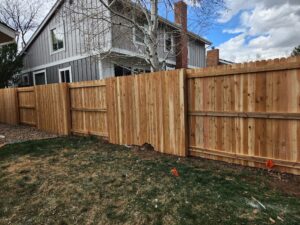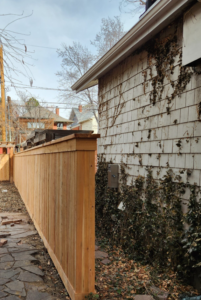If you don’t already know your next-door neighbors, the need to build a fence on your shared property line is the time to make that introduction! A fence is often the one piece of real estate that neighbors share, so it’s a good idea to establish a solid partnership when it comes to repairing or replacing a fence.
One way that you can be a good neighbor has to do with the type of fence you choose. This is where a “good neighbor fence” comes into play. The name comes from not only the design of the fence, meaning that both neighbors can benefit from the “attractive” side of the fence, but also from the collaboration involved.
We’ll show you what a good neighbor fence can look like, and give you tips on how to get started.
Good Neighbor Fence Design

A good neighbor fence means that each neighbor is able to view both the “attractive” and the “ugly” or more utilitarian side of the fence. One neighbor doesn’t get all of the attractive side of the fence, leaving the backside to the other neighbor. If you back up to open space, or don’t have neighbors, this isn’t an issue and you would just put the backside of the fence with the posts showing, facing out. But those living in suburban neighborhoods most often share fences and it’s nice for both homeowners to have an attractive fence in their yard.
The traditional design for this type of fence alternates the panels so that both the front and back of the fence are seen.
Another variation on the good neighbor fence, and one that levels up the attractiveness considerably, is a double-sided fence. If you and your neighbor both want the attractive, front side of the fence showing, and you are both willing to spend a little more, a double-sided fence is a great solution. While it does cost more due to more material used, it really does look nice. In fact, some Homeowners Associations actually require a double-sided fence.

What to Know Before Building a Good Neighbor Fence
Due to its design, a good neighbor fence has a variation in how it’s built from a typical fence. It has to be built on a 7-foot center, instead of the usual 8-foot center, because the material has to run from post end to post end. In a typical fence, the material runs from the center of the post to the center of the other post. A drawback of building on a 7-foot center is that it’s not well-suited for a parcel with elevation changes. However, it does make for a sturdier fence.
If you live in a covenant-controlled community or live within an HOA, be sure to contact them prior to starting your fence project to find out if they have requirements around shared fences. Some HOAs in the Denver Metro area such as in Englewood and Greenwood Village do not allow for a shared fence that shows alternating panels to the neighbors, they require a double-sided fence.

Lastly, communication with your neighbor is key to your shared fence project. If you make your plans together, agree upon designs and costs in writing, and coordinate your schedules, your fence project is set up to go smoothly.
Related Read: Fences and Neighbors: Good Etiquette and Avoiding Disputes
They say “good fences make good neighbors”. This is true for many reasons. And a good-looking, quality fence that pleases both sides can be the beginning of a beautiful friendship. Or at least neighborship.
Learn about our cedar fence building services
